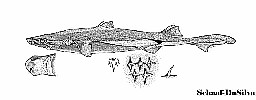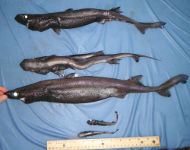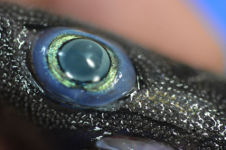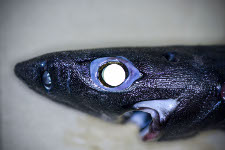Etmopterus sculptus
Ebert, Compagno & De Vries, 2011
Sculpted Lanternshark
Classification: Elasmobranchii Squaliformes Etmopteridae
Reference of the original description
A New Lanternshark (Squaliformes: Etmopteridae: Etmopterus) from Southern Africa. Copeia, 2011(3), 379–384
A New Lanternshark (Squaliformes: Etmopteridae: Etmopterus) from Southern Africa. Copeia, 2011(3), 379–384
Image of the original description
Image in copyright.
Image in copyright.
Description :
Citation: Etmopterus sculptus Ebert, Compagno & De Vries, 2011: In: Database of modern sharks, rays and chimaeras, www.shark-references.com, World Wide Web electronic publication, Version 12/2025
Please send your images of "Etmopterus sculptus" to info@shark-references.com

Sculpted Lanternshark, Etmopterus sculptus, Ebert, Compagno & De Vries, 2011 © Paul Clerkin, Pacific Shark Research Center

Sculpted Lanternshark, Etmopterus sculptus, Ebert, Compagno & De Vries, 2011 © Paul Clerkin, Pacific Shark Research Center
Short Description
Etmopterus sculptus is a moderately large, stout, species of linear-denticled Etmopterus, which separates it from most other members of this genus, and can be distinguished from its three closest congeners within the E. Lucifer-group, E. brachyurus, E. lucifer, and E. molleri, by the length of its anterior flank markings being slightly longer than its posterior branch. The posterior branch of the flank markings on E. brachyurus and E. molleri are shorter relative to the anterior branch, and in E. lucifer, the anterior branch is nearly twice the length of the posterior branch. The new species can also be distinguished from its closest congeners by the arrangement of dermal denticles that extend over most of the upper and lower body surface. Etmopterus sculptus possesses non-overlapping denticles, giving it a rougher, more sculpted texture than these other aforementioned species. The arrangement of the dermal denticles onthe ventral head surface is also a good character for separating these species, with E. sculptus having uniformly distributed denticles while the ventral surface of E. Lucifer and E. molleri is sparsely covered with denticles. The ventral surface of the head of E. brachyurus typically lacks dermal denticles (Ref. 87957).
Etmopterus sculptus is a moderately large, stout, species of linear-denticled Etmopterus, which separates it from most other members of this genus, and can be distinguished from its three closest congeners within the E. Lucifer-group, E. brachyurus, E. lucifer, and E. molleri, by the length of its anterior flank markings being slightly longer than its posterior branch. The posterior branch of the flank markings on E. brachyurus and E. molleri are shorter relative to the anterior branch, and in E. lucifer, the anterior branch is nearly twice the length of the posterior branch. The new species can also be distinguished from its closest congeners by the arrangement of dermal denticles that extend over most of the upper and lower body surface. Etmopterus sculptus possesses non-overlapping denticles, giving it a rougher, more sculpted texture than these other aforementioned species. The arrangement of the dermal denticles onthe ventral head surface is also a good character for separating these species, with E. sculptus having uniformly distributed denticles while the ventral surface of E. Lucifer and E. molleri is sparsely covered with denticles. The ventral surface of the head of E. brachyurus typically lacks dermal denticles (Ref. 87957).
Biology
This species is fairly common along the upper continental slopes between Namibia and southern Mozambique (Ref. 87957); upper slope, on or near the bottom [536]. Observed mostly at depths between 450 and 900 m [535], but with records as shallow as 240 m (in Bass et al., 1976: listed as E. lucifer) (Ref. 87957). Feeds mainly on mid-water bony fish, also squid, octopus, shrimp and brittle stars [536]; Tropical
This species is fairly common along the upper continental slopes between Namibia and southern Mozambique (Ref. 87957); upper slope, on or near the bottom [536]. Observed mostly at depths between 450 and 900 m [535], but with records as shallow as 240 m (in Bass et al., 1976: listed as E. lucifer) (Ref. 87957). Feeds mainly on mid-water bony fish, also squid, octopus, shrimp and brittle stars [536]; Tropical
Size / Weight / Age
Lm ?, range 42 - ? Cm
Lm ?, range 42 - ? Cm
Dentition
Description: Teeth dissimilar in upper and lower jaw; upper teeth multicuspid in three functional series, functional teeth in lower jaw in single series, five to six series of replacement teeth in upper and lower jaw; multicuspid upper teeth small, perpendicular, with long, broad, spear-shaped median cusp flanked by 2–3 lateral cusplets on each side more than onehalf the length of the median cusp, inner most cusplet longest, decreasing in size distally; teeth in lower jaw fused into single row, unicuspid, bladelike, oblique, 30u gradation. Tooth count in first row of upper jaw 23 (23–25) and in first row of lower jaw 38 (36–43) [14026];
Description: Teeth dissimilar in upper and lower jaw; upper teeth multicuspid in three functional series, functional teeth in lower jaw in single series, five to six series of replacement teeth in upper and lower jaw; multicuspid upper teeth small, perpendicular, with long, broad, spear-shaped median cusp flanked by 2–3 lateral cusplets on each side more than onehalf the length of the median cusp, inner most cusplet longest, decreasing in size distally; teeth in lower jaw fused into single row, unicuspid, bladelike, oblique, 30u gradation. Tooth count in first row of upper jaw 23 (23–25) and in first row of lower jaw 38 (36–43) [14026];
Remarks
shark-references Species-ID=11312;
shark-references Species-ID=11312;






















